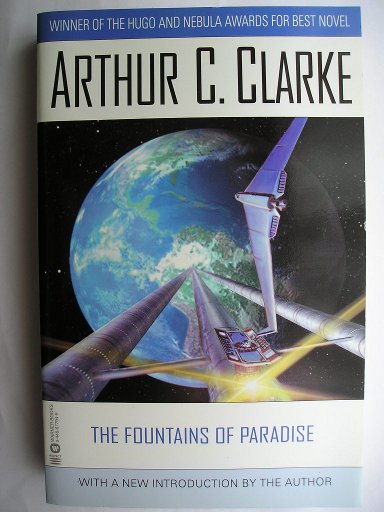
The novel “The Fountains of Paradise” by Arthur C. Clarke was published for the first time in 1979. It won the Hugo and Nebula awards for the best novel of the year.
Vannevar Morgan is an engineer who has designed extraordinary works and now his new dream is to direct the construction of a space elevator. It would be an incredibly complex work that would connect the surface of the Earth to a geostationary orbit about 36,000 km (about 22,300 miles) high. In a future in which part of the solar system has been colonized and many spaceships depart and arrive on Earth, a space elevator would greatly reduce the cost of transportation of people and cargo to orbit.
For Vannevar Morgan it’s not only a huge engineering challenge but before he can start it he must solve economic and political problems. The only place on Earth where a space elevator can be buolt is the island of Taprobane, on top of Mount Sri Kanda, where for centuries there has been a Buddhist monastery whose monks oppose the project.
Arthur C. Clarke had been living in Sri Lanka for over twenty years already when he wrote “The Fountains of Paradise” so he set his novel on an island which corresponds to 90% of it. Taprobane is one of the names used throughout history for Sri Lanka, the story of King Kalidasa is inspired by the true King Kasyapa I, the ruins of the palace of Yakkagala are very similar to the real ones of Sigiriya and Mount Sri Kanda is a higher version of the real Mount Sri Pada. In the novel the island is south of its real location, having been moved to the equator.
“The Fountains of Paradise” is the novel that has made the idea of the space elevator famous. The concept was already old since it was published for the first time in 1895 by Konstantin Tsiolkovsky but Arthur C. Clarke made it known to a wider audience. As typically happens in his stories, Clarke develops this idea with great attention to the technological problems that need to be solved in order to win this huge engineering challenge.
The story of King Kalidasa told in “The Fountains of Paradise” is used to remark the fact that the construction of the space elevator is a triumph of the human intellect and ingenuity. The ancient fountains of paradise were a symbol of the challenge to the gods and one of the themes of the novel is the conflict between rationality and religion.
The space elevator isn’t a Tower of Babel that is built to achieve a hypothetical paradise but a very important step forward in the human interplanetary civilization. In fact, it allows humans to transport people and cargo into orbit much more cheaply than rockets. It’s opposed by the monks who have lived for centuries in a monastery built on the mountain which is the only place in the world where the space elevator could be built.
This is a subject connected to a subplot of the novel that narrates about an alien space probe crossing the solar system. There are some similarities with another of the great novels by Arthur C. Clarke, “Rendezvous with Rama“, but in this case the space probe is active and for a certain period communicates with humans before continuing its journey among the stars. One of the products of the communications of the alien probe is the demolition of religions from a logical point of view.
“The Fountains of Paradise” shows the Arthur C. Clarke’s great optimism about the victory of science and technology over irrationality. A little more than thirty years after its publication that optimism seems just an illusion in a world where so many people claim they can’t understand anything of science and refuse to accept established facts in favor of some faith.
Luckily, there are those who keep on working on scientific and technological progress, also in fields related to the possible construction of a real space elevator. Arthur C. Clarke suggested the use of a carbon crystal to build such a structure and several years later expressed the idea that fullerene, which is another carbon-based molecule, could be used for this purpose. Progress in the research on carbon nanotubes may one day allow us to really build a space elevator.
Arthur C. Clarke also pays attention to the possible hazards that may arise during the construction of the space elevator and again we can see his style. In dealing with the danger, the heroes are not the strongest men who solve the situation with a few well-aimed punches but those who use their intelligence to overcome the problems.
The characters aren’t particularly developed but this is typical of Arthur C. Clarke’s stories. “The Fountains of Paradise” is in many ways an excellent intellectual adventure, although compared to his other stories in this case the author adds his love for Sri Lanka in the strong inspiration to the setting and history of the island.
In the decades following the publication of “The Fountains of Paradise” many other authors have included a space elevator in their stories and the Clarke himself included it in a few of his later stories. In my opinion, this novel is overall excellent and has justly become a classic so I definitely recommend reading it.


Permalink